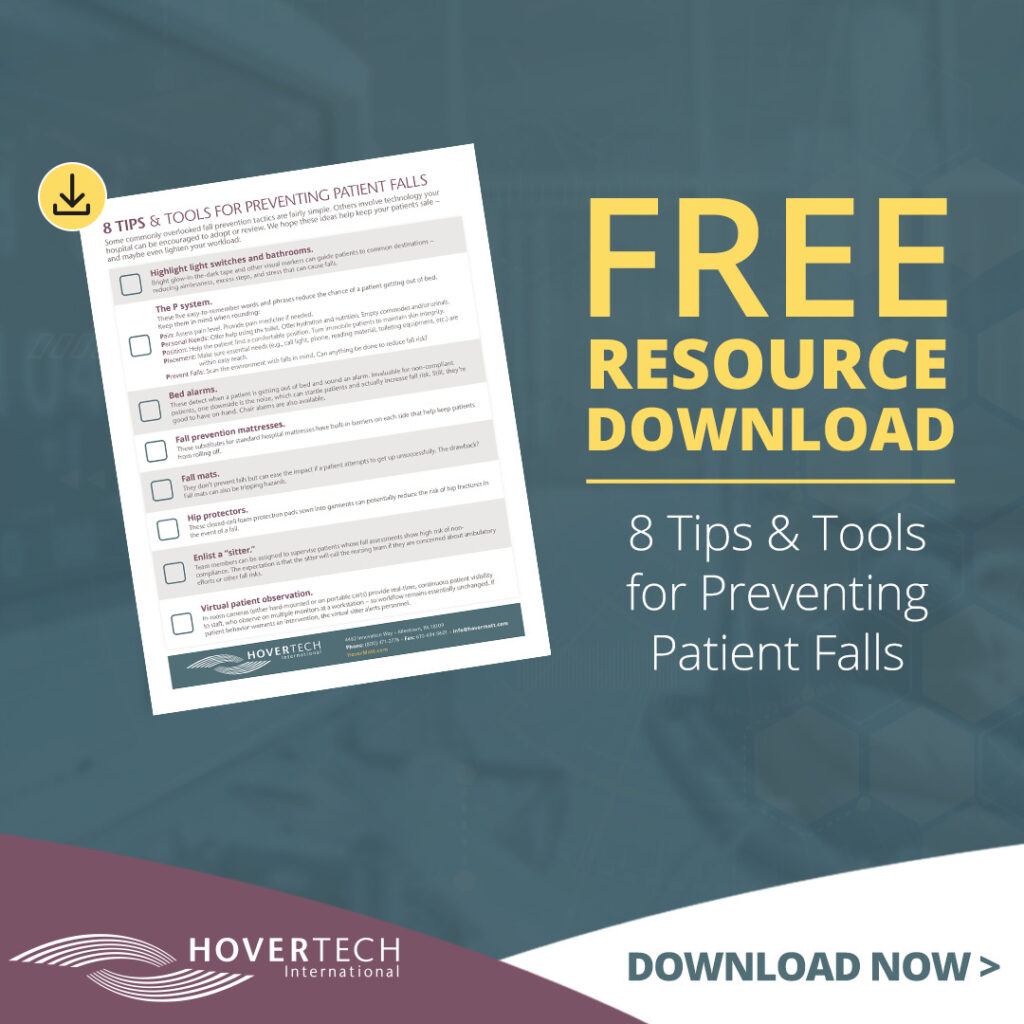Preventing Patient Falls: 8 Overlooked Tips and Tools
Download the FREE tip guide
We find that some of the most overlooked fall prevention tactics are also the simplest. Want to keep these tips handy? Download the 8 Tips & Tools For Preventing Patient Falls.
Rapid Response Team – fall!
As a nurse, it’s the last thing you want to hear over the hospital PA. You work fervently to prevent patient falls, defined as any unplanned descent to the floor or onto another surface (a counter, for example), person, or object. Falls can have direct and psychological impacts including physical injuries, loss of confidence, even death. It’s estimated that 700,000 to 1 million patients fall in hospitals annually. Between 30 and 35% sustain physical injury. Some 11,000 hospital falls each year are fatal.1
Falls come at a steep financial cost, as well. In 2008, the Centers for Medicare & Medicaid Services (CMS) identified injury-causing patient falls as Hospital-Acquired Conditions (HACs) for which CMS no longer reimburses. Healthcare networks and facilities responded by strengthening protocols designed to prevent HACs (also called never events), for good reason: The average cost for a fall with injury is $14,056 – and this total doesn’t include associated operational and emotional costs. From assessing fall victims, enlisting a fall recovery device, communicating with a patient’s family, performing root cause analyses, and completing incident reports – the impact of patient falls on all aspects of healthcare cannot be overstated. Many nurses report feelings of failure and worse when patients fall, contributing to burnout that’s worsening nurse shortages.
Universal Fall Interventions
The likelihood of a patient falling is probably gauged in your healthcare setting by fall risk assessments (also called fall risk screenings). Some examples include the Hendrich II Fall Risk Model, STEADI, or the Morse Fall Scale. These are typically administered at patient admission, change of shift, and repeated at each status change (e.g., when your patient becomes confused). Screenings should include assessment of a patient’s general health status, muscle strength, mental status, coordination, and ability to use assistive devices.
The information gleaned from these assessments empowers caretakers to implement commensurate universal fall preventions. These often include removing tripping hazards from patient rooms, encouraging non-slip footwear, ensuring adequate lighting, educating patients and their families about fall prevention, and setting beds in their lowest position with wheels locked. As you know, it’s a lot of effort. But as data shows, even fastidious implementation of these universal tactics isn’t enough to prevent widespread falling. What else can nurses like you – already overextended – do to further alleviate the risk of falls?
More Tips and Tools
We find that some of the most overlooked fall prevention tactics are also the simplest. Others involve technology your hospital can be encouraged to adopt or review. Acknowledging chronic demands on nurses’ time and resources, we nonetheless encourage you to consider these tips and tools:
Highlight light switches and the bathroom.
Bright glow-in-the-dark tape or other visual markers can help guide patients to possible destinations, reducing aimlessness, excess steps, and stress that can lead to falls.
The P system
The P system is comprised of five easy-to-remember words and phrases each beginning with the letter P. Keep this checklist in mind when rounding on a patient, as each reduces the chance of a patient getting out of bed:
Pain:
Assess the patient‘s pain level. Provide pain medicine if needed.
Personal Needs:
Offer help using the toilet. Offer hydration and nutrition. Empty commodes and/or urinals.
Position:
Help the patient find a comfortable position or turn immobile patients to maintain skin integrity.
Placement:
Make sure essential needs (e.g., call light, phone, reading material, toileting equipment, etc.) are within easy reach.
Prevent Falls:
Scan the environment with falls in mind. Can anything be done to reduce fall risk?
Bed alarms.
These detect when a patient is getting out of bed and sound an alarm. Invaluable for non-compliant patients in particular, one downside of bed alarms is the noise they create, which can actually increase fall risk by startling patients. Still, they can be helpful to have on-hand. Chair alarms are also available.
Fall prevention mattresses.
These substitutes for standard hospital mattresses have built-in barriers on each side that help prevent patients from rolling off.
Fall mats.
They don’t prevent falls but do provide additional padding that can ease the impact if a patient attempts to get up unsuccessfully. The drawback of fall mats is that they can also be tripping hazards.
Hip protectors.
Worn under clothing, hip protectors are closed-cell foam protection pads sewn into the garments that can potentially reduce the risk of hip fractures in the event of a fall.
Enlist a “sitter.”
If a fall assessment suggests a patient will not comply with strategies for fall prevention, another team member can be assigned to supervise them. The expectation is that the sitter will call the nursing team if they are concerned about ambulatory efforts or related fall risks.
Virtual patient observation.
In-room cameras (either hard-mounted or on portable carts) provide real-time, continuous patient visibility to staff, who can observe on multiple monitors at a workstation – letting workflow remain essentially unchanged. If patient behavior warrants an intervention, the virtual sitter alerts appropriate personnel via methods available through their facility’s system.
Want to keep these tips handy? Download the 8 Tips & Tools For Preventing Patient Falls.
For more resources and education about safe patient handling, reach out to HoverTech.
1 LeLaurin JH, Shorr RI. Preventing Falls in Hospitalized Patients: State of the Science. Clin Geriatr Med. 2019 May;35(2):273-283. doi: 10.1016/j.cger.2019.01.007. Epub 2019 Mar 1. PMID: 30929888; PMCID: PMC6446937.

